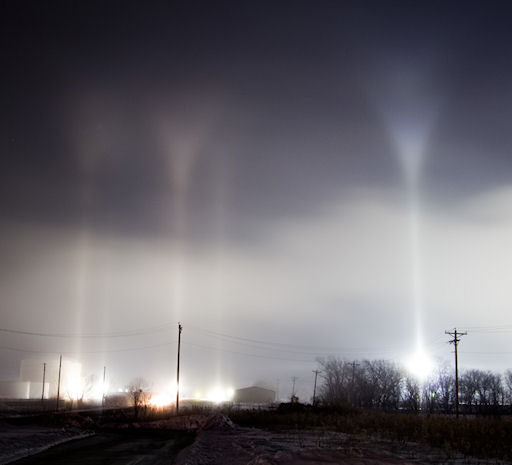Atmospheric Phenomenon --V-TOPPED LIGHT PILLARS
V-TOPPED LIGHT PILLARS: Light pillars are a common sight around cities in winter. Urban lights bounce off ice crystals in the air, producing tall luminous columns sometimes mistaken for auroras. But the light pillars Mike Hollingshead saw last night near a corn mill in Nebraska were decidely uncommon. "They had V-shaped tops," he explains, "and some of the Vs were nested." Here is what he saw:
"These light pillars are not just rare, they are exceptional!" declares atmospheric optics expert Les Cowley. "Ordinary pillars are produced by plate-shaped ice crystals roughly half way between you and the light source. These are different. Their rarely seen flared tops show that they were made by column-shaped crystals drifting slowly downwards and aligned horizontal by air resistance."
"The flares are a form of the upper tangent arcs that we sometimes see in daytime halo displays," he continues. "But even more exotic, some flares have a second one nested within them! Some ice crystal columns do not rotate but instead keep two of their prism faces improbably horizontal to give us the very uncommon Parry arcs of solar halo displays. The nested flares here are amazing and probably the light halo equivalent of Parry arcs."
Columns of light apparently beaming directly upwards from unshielded (and wastefully polluting) lights are sometimes visible during very cold weather. Plate shaped ice crystals, normally only present in high clouds, float in the air close to the ground and their horizontal facets reflect light back downwards.
The pillars are not physically over the lights or anywhere else in space for that matter ~ like all halos they are purely the collected light beams from all the millions of crystals which just happen to be reflecting light towards your eyes or camera.
When ice crystals float in the air around you, pillars (and other halos) can even be seen around streetlights a few metres away.



 Earth's magnetic field:
Earth's magnetic field:

0 Comments:
Post a Comment
<< Home